Driving in Brazil
Driving in Brazil is sometimes more than an option, due to the poor quality of most cities' public transportation. Any foreigner is allowed to drive for up to 180 days with their country's driving license, unless it expires earlier. After the 180-day period, you must apply for some tests in order to obtain your license.
Understand
Brazilian roads can vary drastically from city to city in terms of quality. Also, due to the lack of sufficient highway/traffic police staff, it's easy to witness drivers doing otherwise forbidden actions such as driving on the shoulder, going above the speed limit, overtaking in dangerous situations, etc., but this does not apply to most drivers. Brazilians drive on the right side of the road, with the steering wheel on the left side. Most cars are manual, but the automatic ones are getting more and more common.
Roads


Roads that connect one state to another are federal highways known as BR-000, in which "000" should be replaced by another three-digit number. If this number starts with 0, then the highway starts at Brasília and run towards the extremes of the country; highways starting with 1 run north-south, whereas the ones starting with 2 cross the country from east-west; highways starting with 3 run northwest-southeast or northeast-southwest. There are also the ones starting with 4, which run in any direction, and the ones starting with 6, which are always short.
State highways are inside a single state, and instead of "BR" there'll be the two-letter code of the state (e.g. SP-160 stands for São Paulo State Highway 160). Both federal and state highways can be either motorways or divided or undivided highways with at grade crossings. In addition there are of course minor roads that usually aren't paved — indeed out of the country's 1,750,000 kilometers of roads about 5.5% is paved.
Roads can be government-financed only, or they may have some tolls. The price may vary from R$ 1,50 to R$ 20,00 depending on the road, the number of booths spread along the highway and the type of vehicle you are driving. Prices are usually displayed at the booths and in signs placed a few kilometers before each of them.
Many highways have speed guns to prevent motorists from going too fast, but their presence and the speed limits must be informed according to the law. However, their exact location may remain unknown for motorists, so it's always best to respect the signs.
Highways may become congested during the beginning and the end of holidays, or during rush hour, if they run near major cities. If the traffic stops inside a tunnel and there's no sign that you are going to move too soon, drivers are advised to turn the engine off. There are usually fewer cars late at night, but due to the low visibility, it also becomes more dangerous, especially for inexperienced drivers. Motorists should also be careful with truck drivers, since many of them sleep very few hours a day and may fall asleep at the wheel.
Many roads are in good condition, especially in the east and south of the country and along the coast. In other areas and outside the metropolitan regions there are also gravel and dirt roads for which an off-road vehicle can be strongly recommended. This especially applies to the Amazon area where many roads are difficult or not at all passable during the rainy season from November to March. This is why it is advisable to travel with a good map and to be well informed about distances, road conditions and the estimated travel time.
Signs and regulations
General
Brazilian road and traffic signs in general follow the international conventions. STOP signs are in general similar to the ones found in the English-speaking world, except that obviously they will be displaying the word PARE (stop, in Portuguese). These signs require a vehicle be stopped at an intersection and not proceed until the way is clear. Stopping is mandatory, no matter what time of day or the traffic conditions. Sometimes, the PARE sign may be written on the ground, in white letters. The "give way" sign is displayed in an equilateral, red-edged triangle pointed downwards. They are normally displayed in accesses to highways or smaller roads, meaning you should only get in if the way is clear.
Road markings
Roads can be marked by yellow or white lines. Yellow lined separate each side of the road. In highways, if they are continuous, overtaking is prohibited (though few people respect that). If they are broken, it's OK to overtake. White lines separate lanes. Some may be painted at intersections, marking the point beyond which no vehicle should stop at the red lights.
Some cities have bus lanes. In general, these lanes are forbidden for cars unless the car is a taxi, or during specific times and days. If the bus lane is on the far right lane, vehicles may only use them when entering or exiting the street. Bus lanes marked with blue lines are exclusive to public transport, meaning the driver can receive a ticket for using them unless they're entering or exiting the street. Some bus lanes are marked with regular white lines, and the word ÔNIBUS (Portuguese for bus) written on the ground, also in white paint. These lanes are preferential rather than exclusive, and any driver can use them, although it is common courtesy to avoid them in heavy traffic situations.
Pedestrian crossings
Zebra crossings (faixas de pedestres) are always painted as white, parallel lines. Some may be even highlighted in other colors such as purple. When there is a zebra crossing with no traffic light, drivers are supposed to stop and wait until the road is totally clear of pedestrians. However, obedience to this law is poor, particularly in major cities. In São Paulo, a recent law has increased police enforcement for this traffic offense and the number of people hit by cars decreased, but the streets may still be dangerous for pedestrians if they do not pay attention. Also, some green lights may be too short for elderly or disabled people to completely cross the road.
Speed limits
Unless otherwise specified, speed limits in Brazil are normally as follow:
- Residential/local streets: 30 km/h;
- Avenues: 60 km/h;
- Highways (urban areas): 80 km/h for cars and motorcycles, 60 km/h for buses and trucks;
- Highways (rural areas): 110 km/h for cars and motorcycles, 80 km/h for buses and trucks.
This may vary, but the speed limit will always be specified by signs (see the image to the right).
In places without speed guns, few people will respect the limits, so it is always best to stay in the slower lanes or let people overtake you if you don't want to disrespect the law.
Speed bumps
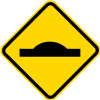
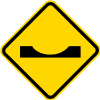

Many Brazilian streets, avenues and sometimes even highways have speed bumps (lombadas or quebra-molas). They should all be well indicated with signs and yellow diagonal strips painted on them, but in less developed areas they may be hidden. In the states of Maranhão and Pará, dips are more common, and reportedly make worse damage on the shocks.
Traffic lights
Traffic lights in Brazil are known as semáforos, faróis or sinais, and standardized with red on top, yellow in the middle, and green at the bottom. Some may be horizontal, with red on the left, yellow in the middle and green on the right.
The lights work as follows:
- Red: stop and stay stopped until the light goes out. You cannot turn right on the red signal, even if this turn isn't against traffic, unless a direita livre sign is placed next to the traffic light.
- Red arrow: stop for the direction of the arrow.
- Yellow: stop unless you cannot safely do so, because the lights are about to turn red.
- Flashing yellow: It means the lights are not working. Unless there is a traffic controller operating at the problematic intersection, the "every driver for himself" rule applies, which means you'll have to somehow negotiate your way with every motorist around you. Some traffic lights, mainly those with the exclusive purpose of allowing pedestrian crossing are generally deactivated between 11 p.m. and 5 a.m. and will display the flashing yellow light.
- Green: you may proceed unless the way ahead of you is not clear and you're not sure if it'll be until the lights turn red again. If you block the intersection, you may cause a traffic jam and be issued a fine.
- Green arrow: you may proceed in the direction of the arrow, provided the conditions described above.
- Red and green person: used at pedestrian crossings beside the lights. Instead of a yellow light, the red light will flash when the lights are about to turn green for cars.
Safety rules
You should wear your seat belt at all times when you are driving. Also, the number of functioning seat belts determines the number of passengers a vehicle can carry. As of 2016, it is mandatory to have your headlights on at all times when on a highway. Also, keep an eye on your tires and the fire extinguisher's shelf life. If you have an emergency, stop with the emergency lights on and place the reflective triangle some 10 m away from your car. Some drivers even put large branches to increase visibility.
Cellphones are strictly forbidden without a hands-free device. A driver can be fined for as much as holding a cellphone, even if the car is not moving.
It is forbidden to drive shirtless, while wearing flip-flops or high-heels, or with your elbow (let alone your arm) resting out the window.
Children
According to Brazilian law:
- Children under the age of 10 must always ride in the back seat. If you're carrying more children than the back seat allows for, the tallest one is allowed to ride in the front seat. This does not apply for children under the age of 1;
- Children under the age of 1 must ride in rear-facing seats;
- Children between the ages of 1 and 4 must ride in front-facing seats;
- Children between the ages of 4 and 7 must use booster seats.
Drive
Driver-to-driver communication

Brazilian drivers will constantly use the blinker, the horn, the flashing lights and their hands to communicate with other motorists.
- If you are exiting a parking lot, garage, gas station or something like that and trying to enter a street but there are too many cars, one of them may stop for you to come in. They will often make their intentions clear by flashing their lights, sounding their horns or making a "come in" gesture with their hands. Some will just stop and wait for you to enter. If you want to say "thank you", you may happily sound your horn "beep-beep", or make a "thumbs-up" sign with your hand. If you are on a two-way street and want to take a left, the oncoming vehicles may use the same signals described above to give you passage.
- If the oncoming cars start flashing their lights on you, they may be warning you about possible hazards ahead, for instance in rural areas it's common that domestic animals are left at the roadside, and they sometimes wander into the traffic. Some also do this to alert about police checkpoints, called blitz (plural: blitzes), although this practice is illegal.
- If oncoming drivers signal you by raising their arms up and down outside the window, it means you should reduce your speed as there are possible hazards ahead.
- When driving in the fastest lane of a highway and the car behind you flashes its lights, or turns the left blinker on, the driver is asking you to get out of their way.
- Motorists also use the flashing lights and the horn to complain if you cut off in front of them.
- When switching lanes or entering major avenues and streets, some drivers may put their hands out of the car and make a "slow down" sign. This means they are really willing to get in your way, and you should just let them in.
- On highways, if the car in front of you brakes and turns the emergency lights on, stop immediately and turn your lights on as well. It means there is a sudden traffic jam or hazard ahead.
Motorcycles
Motorcycles are a particular problem of Brazil, especially in major cities. Many bikers die every day due to accidents. They ride between cars all the time, so be extremely careful when switching lanes. If you hit one of them, several others may gather around you and threaten you; try to avoid getting involved in an accident with them. Be careful also when taking a right or a left, for they may try to overtake you even if you turn the blinker on. If the traffic comes to a stop, make sure to leave enough space between you and the car next to you for bikers to go by, as some may be aggressive and damage your car if they can't get through.
Motorcycles are also the vehicle of choice for robbers, so be careful if you are approached by one of them at night, especially if there are two individuals on it.
Bicycles
The number of Brazilians that opt for bicycles is increasing, and some major cities, such as São Paulo, have been creating bike lanes. In places without bike lanes, bikers must ride on the shoulder (acostamento). If there are parked cars, they will go between them and the traffic. Try to keep a safe distance from them (say, 1.5 m), and be sure they are at a safe distance when exiting the road. Many bikers don't wear any protection such as helmets, so any accident may cause them severe injuries. In highways with shoulders, bikers must cycle on that part of the road.
Parking

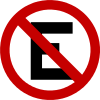
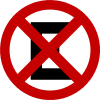
Most streets and avenues are available for parking, except otherwise noted by signs such as the ones to the right.
Parking lots
In major cities, it is always easier and safer to leave your car in a paid parking lot. These parking lots must inform their prices at their entrances. All of them must also have insurance for collisions, fires and robbery. However, this only applies when the entire car is robbed; they won't take any responsibility for valuables left inside the vehicle, unless they explicitly inform you of that. As such, it is always best to take your valuables with you. In some of the parking lots, you can park your car and take the keys. In others, you may leave the car for someone to park it properly.
Flanelinhas
In most major cities, some streets may have "flanelinhas", which are irregular, usually male and adult workers that look after parked cars and help people find places to leave their vehicles. Although the activity is illegal, enforcement is poor for this particular crime, and sometimes the cops are in with the workers, that get totally free to operate.
They will usually charge you at the moment you leave your car. Never refuse to give him some money. He may punish non-payers by popping their tires or damaging their cars when there's no one watching. In worse cases, they may even threaten you, verbally or physically. If you just don't feel like paying the guy, find a clear street or a private parking lot. Also, don't leave your keys with them if they ask you so. Some may be honest, but since you're never sure about their real intentions, you may have your car stolen right in front of your eyes.
Fuel and gas stations

There are many gas stations (postos de gasolina or simply postos) all over Brazil and along the major highways. Five types of fuel are available and can usually be identified by the color of the nozzle:
Available at virtually all gas stations:
- Regular gasoline (gasolina comum); red nozzle.
- Premium gasoline (gasolina aditivada). Some gas stations carry more than one variety; blue nozzle.
- Ethanol (etanol or álcool); green nozzle.
- Diesel. Only for larger vehicles such as SUVs, trucks and buses; yellow nozzle.
Natural gas (gás natural) is available at many gas stations, but sometimes hard to find. It requires previous adaptation of the vehicle, and is mostly used by driving schools and taxi drivers.
Fuel is relatively expensive, with the gasoline price ranging from R$ 3,80 to R$ 6,00 per liter, depending on the region, brand and the location of the station. Most gas stations also sell fire extinguishers, gasoline additives and motor oil. Some also have convenience stores and public toilets.
Most cars in Brazil are equipped with flex fuel engines, meaning they can function with any mixture from 100% ethanol to 100% gasoline. Ethanol is cheaper than gasoline and results in a slightly more powerful response, but using ethanol increases consumption. As a general rule-of-thumb, ethanol should be used if its cost is not higher than 70% the cost of gasoline (i.e. if 1 liter of gasoline was R$ 1, you should use ethanol if its cost were R$ 0,70 per liter or less). Most gas stations display this information along with the prices or on each individual pump. When driving for long distances, however, gasoline is always the best option since its reduced consumption allows for longer range and fewer fueling stops. Using ethanol also makes it more difficult for the car to start, especially when the engine is cold and under colder temperatures. For this reason, flex fuel cars have a separate reservoir at the front of the vehicle, called the "cold start reservoir" (reservatório de partida a frio) which should be filled with (preferably) premium gasoline. When the engine detects a high quantity of ethanol in the fuel mix, it uses the gasoline from this reservoir to start the car. It is also a good idea to make sure the engine runs for at least half an hour after switching from gasoline to ethanol or ethanol to gasoline, to make sure the engine's lambda sensor has enough time to detect the new mix and make the necessary adjustments.
All gas stations are serviced; self-service pumps are illegal in Brazil. The employees (called frentistas) will often offer to check the oil and water levels and, in the case of highway gas stations, to clean your windshield at no extra charge, although it is not impolite to tip them for those services.
Tire inflation machines are available at virtually all gas stations and are usually self-service. Although free at many gas stations, some charge for using them (generally R$ 1). PSI is the standard unit for tire pressure. Gas station attendants will gladly inflate your tires for you if you ask them. Again, it is not impolite to tip them for this service.
Unless absolutely necessary, never use gas stations that don't belong to one of the major brands (Petrobrás, Shell, Ipiranga and Ale), especially if they offer below average prices. Gas stations like that often scam customers by selling diluted fuel which can severely damage the vehicle.
Most gas stations will accept credit cards as payment, although they may charge different prices for that payment method. Virtually all gas stations accept debit cards, charging the same price as for cash payments.
Running out of fuel is considered lack of maintenance, just as illegal as driving with busted head/tail lights or bald tires. Keep the vehicle fueled to avoid being fined.
Stay safe
- See also: Brazil#Stay safe
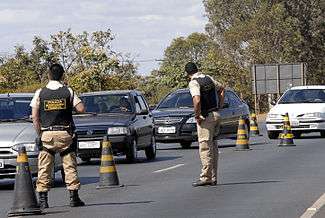
Driving at night
As mentioned before, driving at night may be dangerous in less developed areas due to the lack of visibility and street lights. It is always best to avoid stopping at the red lights due to the risk of being robbed. However, try not to do this before checking if there are no other cars crossing the intersection. If other cars around you stop, you should stop as well, unless you see someone suspicious approaching your car (never accelerate if the person is already too close, if it's a criminal, they may shoot you). If the light ahead of you is red, slow down and approach is slowly, reducing the time you'll spend in a full stop. Avoid stopping at a red light with the windows open and always check your rearview mirrors for suspicious individuals.
Highways at night may have street racing or lone drivers that enjoy speeding. That said, drive carefully and try to keep your distance from them.
If someone hits you at night, it may be a criminal forcing you to stop. Try leading them to a place with more people (say, a police station, a hospital, a 24 hour gas station, etc.). Also, if your windscreen gets hit by a stone or slime-jammed when you go under a pedestrian separation structure, it is surely a criminal using another common way of forcing people to stop. If you can still see the road ahead of you, try stopping in a police station or any other place with people to ask for some help. If you stop immediately, you are guaranteed to be robbed or kidnapped.
Accidents
If you are involved in an accident, never leave the scene. If it is a minor accident, you and the other driver may stop somewhere else to discuss in order not to cause a traffic jam. It's possible but not likely that the other drive will speak English, so it's always best to call the police (190) in order to resolve the situation. If there are victims, you must call an ambulance. According to Brazilian law, if you rear-end someone, the fault is always yours, the only exception being when the other car is leaving a parking garage. Also according to the law, in the case of an accident, the driver with the larger vehicle is responsible for making sure the driver and passengers of the smaller vehicle are safe and tended to by a trained first responder (i.e. if you hit a motorcycle with your car, you're responsible for making sure they're not hurt and, in case they are, you're responsible for calling an ambulance).
Drunk driving
Since 2008, Brazilian law is very strict. You are only allowed to contain 200 mg of alcohol for every liter of your blood, which means that even a can of beer may leave you unable to drive legally. The police efforts to reduce the number of people that drive under influence have improved, but the number of drunk drivers is still high, also due to the scarcity of nightly public transportation. Police presence is relatively high in bohemian neighborhoods and in cities that receive a great amount of tourists during holidays. If you are stopped by the police, they cannot force you to blow into the breathalyzer, but if you are clearly drunk, they may arrest you and you may face criminal charges. Refusing to blow into the breathalyzer means you'll receive a steep fine for refusing to comply with a law-enforcement agent, and the car will be impounded all the same. In other words, if you want to drink and drive, do it at your own risk.